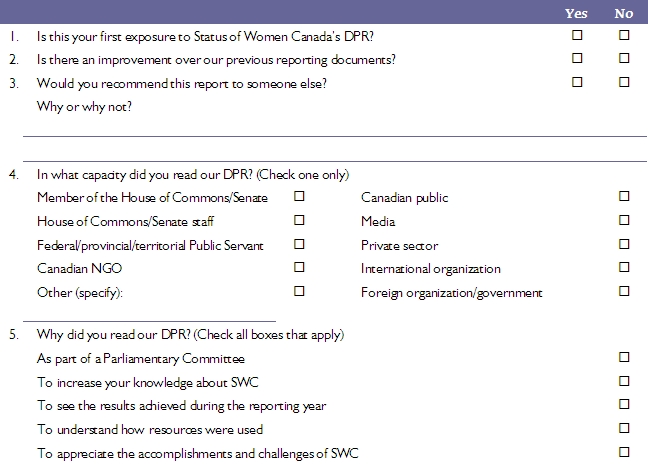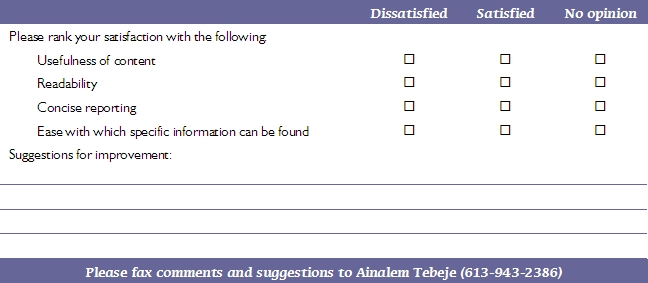Common menu bar links
Breadcrumb Trail
ARCHIVED - Status of Women Canada
 This page has been archived.
This page has been archived.
Archived Content
Information identified as archived on the Web is for reference, research or recordkeeping purposes. It has not been altered or updated after the date of archiving. Web pages that are archived on the Web are not subject to the Government of Canada Web Standards. As per the Communications Policy of the Government of Canada, you can request alternate formats on the "Contact Us" page.
Section IV – Other Items of Interest
In 2007–2008, change management was a key priority for SWC. To manage the strategic and operational changes effectively, measures were taken to streamline existing processes, create new systems, strengthen staff capacity, and acquire relevant expertise through staffing actions and/or training. For 2007–2008, the resources associated with corporate elements among the two program activities were estimated as follows:

Program Delivery Model
In addition to the two funding components, SWC introduced calls for proposals to administer the WP. These changes required, among others, the development and/or enhancement of tools, a more proactive outreach strategy, an enhanced and standard review process, and a greater use of the information technology. The streamlined process and improved tools facilitated a broader program reach and increased efficiency in program administration.
By creating the WPF, SWC is investing strategically in women’s issues. This Fund is crucial in that:
- it facilitates the engagement of different players in advancing equality for women, thereby creating a partnership among public, private, and voluntary sectors, and sustained ownership of the solutions required to address challenges.
- it enables SWC to leverage funding, expertise, and networks from partners, increasing the level and diversifying the sources of funding needed to advance equality for women and girls in Canada.
- it supports collaborative projects that enable SWC to build partnerships within and beyond the federal jurisdiction in order to address systemic barriers that impede the full participation of women in Canadian society.
Corporate Services
Human Resources
SWC has implemented effective Workforce Adjustment measures to address various staff issues. It hired new employees and provided training to ensure business continuity and to meet the new service standards created during the transition. As part of its governance structure, SWC also proceeded with the staffing of key positions both at the executive level and throughout the organization. There are ongoing impacts being experienced in 2008–2009 from the implementation of Workforce Adjustment measures in 2006–2007, 2007–2008.
Information Technology
As part of its corporate priorities, SWC modernized its information technology (IT) infrastructure as planned in its Network Architecture Modernization Project (NAMP). It also began phase two of the NAMP by installing VMW servers to virtualize the IT infrastructure, ensure business continuity, and reduce maintenance costs.
Communications
The changes of 2006–2007 and the ensuing transition period in 2007–2008 generated considerable public and media interest. This had an impact on SWC due to the extent of demand for its communication services, both in terms of access to information and engaging the public.
In 2007–2008, SWC maintained regular and ongoing contact with the public, its partners and key stakeholders in order to provide timely and accurate information about its activities. This communication served not only to inform the public, media, parliamentarians, and other stakeholders, but also to respond to enquiries about the status of the organization and the change process.
Lessons learned: The year 2007–2008 saw the transformation of SWC both in its strategic direction and operational activities. This transformation provided key lessons, including those pertaining to the shift, in the delivery of SWC’s mandate, toward a more strategic and focused approach with a more direct impact on women. For example:
- By focusing its support and capacity building activities in key areas, including accountability mechanisms (in central agencies and select federal departments), SWC was able to make encouraging progress in its efforts to facilitate the integration of gender-based analysis in the development and analysis of public policies and programs.
- By streamlining its program delivery model, (e.g., introduction of two funding components, use of calls for proposals), SWC was able to broaden its reach, ensure a direct impact on women and build strategic partnerships so as to engage a broad section of Canadians in the efforts to advance equality for women.
Looking Beyond Transition
As indicated in the previous sections, the reporting year provided SWC with opportunities to enhance its performance and achieve concrete results. At the same time, it was also a period of challenges that required strategic action. SWC is now looking beyond this transition period and seizing the opportunities that have been created with the renewal of the organizational directions. As such, it will continue its efforts to achieve a higher degree of excellence by building on the successes and lessons learned in 2007–2008.
With a number of exciting initiatives in the horizon, SWC has much to look forward to in 2008–2009 and beyond. Some of the future initiatives are:
- the announcement in the Budget 2008 of “an Action Plan that will advance the equality of women across Canada ...” The Action Plan will require SWC to develop an implementation strategy that will deliver on the government agenda of advancing equality for women. In support of the Federal Action Plan for Women, SWC initiated a number of strategic partnerships to advance women’s economic security and prosperity, to address violence against women and to increase the participation of women and girls in leadership roles across society.
- SWC, in collaboration with other federal departments, started work on a framework for a set of equality indicators to track the situation of women, identify gaps and to monitor the progress made toward the full participation of women in Canadian society. This framework, to be finalized in 2008–2009, focuses primarily on women’s economic security and personal
safety.
Statutory and Departmental Reports
- Status of Women Canada 2007–2008: Report on Plans and Priorities
- Status of Women Canada 2006–2007 Departmental Performance Report
For other reports/documents of public interest, please visit the SWC Web site: http://www.swc-cfc.gc.ca.
Contact Information for the 2007–2008 DPR
For questions on financial information provided in this DPR, please contact:
Cindy Paquette
Corporate Services
Telephone: 613-947-1453
Fax: 613- 947-6113
E-mail: Cindy.Paquette@swc-cfc.gc.ca
For other questions, contact:
Ainalem Tebeje
Communications and Strategic Planning
Telephone: 613- 995-1811
Fax: 613-943-2386
E-mail: Ainalem.Tebeje@swc-cfc.gc.ca
Annex A – Feedback on the 2007–2008 DPR
Thank you for taking the time to review our DPR. We welcome your comments and suggestions which we will use to enhance the quality of our performance as well as plans and priorities reports.


